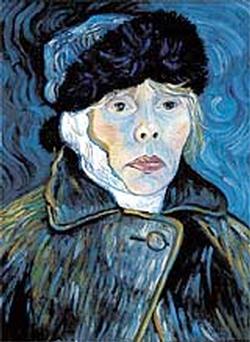For Joni Mitchell, Artist, Singing Was Not Enough
by James Brooke
New York Times
August
22,
2000
 |
| Joni Mitchell's van Goghesque self-portrait was an album cover. |
SASKATOON, Saskatchewan -- In a report card note to the parents of Roberta Joan Anderson a few decades back, the sixth grade teacher at Queen Elizabeth School here offered this starchy recommendation: "Joan should pay attention to other subjects than art."
Almost half a century later, Joni Mitchell has come home to this city in the Canadian prairies where she grew up and where her parents still live. And she has brought her art with her.
From 500 paintings, drawings and photographs made over the last three decades, Gilles Hébert, director of the Mendel Art Gallery, a public museum, has selected 87 pieces for Ms. Mitchell's first retrospective show, called "voices: Joni Mitchell." As recordings of her folk, jazz and rock songs echo gently through the boxy teak galleries here, visitors explore an artistic side to the singer only hinted at in the album covers she has painted over the years.
The show includes prairie landscapes, photo montages in which Ms. Mitchell's flaxen hair blends into wheat fields, and cubist oils. There are abstract paintings that at first were hung upside down at the gallery, brightly colored pop portraits in the Peter Max style, a portrait of Georgia O'Keeffe with a Southwestern feel and an erotically charged oil showing a man's hand on a woman's black-stockinged knee.
The show opened on June 30, attracting such crowds to the museum, which overlooks the South Saskatchewan River, that streets were blocked to traffic. With some fans making 1,000-mile pilgrimages, the Mendel expects to double its normal attendance during the show, which runs through Sept. 17. "We are averaging one thousand people a day," Mr. Hébert said. "That is amazing to me in a city of 210,000 people."
The show is here because this unpretentious prairie city is home to her parents and to her boyfriend, Donald Freed, also a singer-songwriter. It is rare because Ms. Mitchell, who has plenty of wealth and fame from her music, paints for herself, occasionally giving a work to a friend. "I sing my sorrow," she likes to say, "and I paint my joy." "When you are writing, you need to have a kind of chaotic mind for stimulation," Ms. Mitchell said in a telephone interview after returning to her Bel Air mansion in Los Angeles from the opening here.
"Painting is a completely different mental process. It completely clears my mind until I get to the point where I have no thoughts. I get the same charge from juxtaposition of colors as I do from juxtaposition of chords."
 |
The singer attended the opening of her show at the Mendel Gallery.
Photo by Glen Berger. |
Mr. Hébert, the show's curator, described long conversations with Ms.
Mitchell about art and music. "You never really know which discipline she is talking about," he said. "She slides from one to the other. She will talk about colors chiming or about how tension built up because of discord in her choice of colors. She talks about harmony, she talks about resonance: these are the terms she uses to describe her art."
Ms. Mitchell, now 56, started drawing at age 10 when she was bedridden with polio. She calls her songs audio paintings.
In
A Case of You, she wrote and sang, "Oh I am a lonely painter/I live in a box of paints."
Generally, Ms. Mitchell's painting style has shifted and evolved in tandem with her music. Referring to late 1960's portraits of Neil Young, a fellow musician and longtime friend from the Canadian prairies, she remarked, "Those line drawings were done at the time when my first records were basically music and guitar. At the time, I started overdubbing my music. I added color to the line drawings, sometimes after the fact. Then as my music got jazzier, I painted abstractly. Now that I am going through a neo-classical style, the painting goes through a neo-classical style."
In a review last month in The Globe and Mail, edited in Toronto, Robert Enright, a curator, arts editor and television critic, described Ms.
Mitchell as a "worldly version of a naïve artist, indifferent to art trends and the positioning that has so much to do with contemporary art."
While her name will draw people to the museum, he wrote, "her genuine aspiration to be an artist is what will keep them there long after the novelty wears off of a pop icon who paints."
In the telephone interview, Ms. Mitchell recalled always having had a love for art. She remembers seeing her first Picassos and Matisses at the house of Frederick S. Mendel, a classmate's grandfather, who in 1964 started the museum where her show is now running. Her formal art training lasted only one year, at an art school in Calgary, Alberta, in the early 1960's.
TURBULENT INDIGO, one of the 20 album covers she has painted over the last 32 years, graces the exhibition's poster and the cover of its catalog.
A self-portrait in blue tones, it shows Ms. Mitchell wearing a bandage over her right ear in a reference to van Gogh's 1889 self-portrait. Ms. Mitchell painted it in 1995, a period when she felt that the music industry was ignoring her.
"Of all the painters I felt most kindred to, I felt most touched by van Gogh," she said. "Van Gogh was impulsive. For him, art was like sex on the kitchen table."
Ms. Mitchell readily acknowledges that she is vulnerable to charges of dilettantism.
After addressing an artists' conference in 1993 on one of her frequent visits home, she read an article in The Star Phoenix, Saskatoon's daily newspaper, in which local painter was quoted as saying that he didn't need a rich rock star telling him that she was a serious artist.
In her defense, she said she devoted herself obsessively to her paintings, sometimes neglecting her music to stay up all night to rework a painting in her home studio. Of one oil, she said: "That piece wouldn't let me eat, sleep, go to the bathroom. It was completely compelling."
"The art world has a problem with my day job," she continued. "The main trouble with showing my work is that people have a hard time, knowing that I am a musician. They say I am a folkie, a rocker, whatever. This is not a renaissance culture. This is a culture of specialists."
The show opens with what she calls her cubist works, montages of brightly colored scenes representing different views of a California beach.
Although she has lived in California since 1968, she prefers Canadian scenes, often painted from snapshots taken during visits here.
"I go home for renewal," she said.
 |
| "40 Below 0," a painting by Joni Mitchell in her show at the Mendel Gallery in Saskatoon, Saskatchewan. |
She has drawn particular praise from some critics for "40 Below 0," a
1995 oil depicting an untracked winter road cutting across a snowy landscape while a warm sun sinks over a farm horizon.
She described the jeep ride with Mr. Freed that inspired the work.
"We were driving on what might be considered the bleakest stretch of road, on the bleakest time of year," Ms. Mitchell said. "When I got out, crystals formed all over the inside of the windshield.
"There were the prairies, the stretch of the wind, the movement of the clouds, the skies, all lilac-y and yellow. The windbreak was burgundy, the snow was pink with the sun going down. It was such a rush of color. To be so cold it could kill you in 15 minutes, and yet to look so warm. I felt like a salmon smelling its native stream."
Printed from the official Joni Mitchell website. Permanent link: https://jonimitchell.com/library/view.cfm?id=2100
Copyright protected material on this website is used in accordance with 'Fair Use', for the purpose of study, review or critical analysis, and will be removed at the request of the copyright owner(s). Please read 'Notice and Procedure for Making Claims of Copyright Infringement' at JoniMitchell.com/legal.cfm


